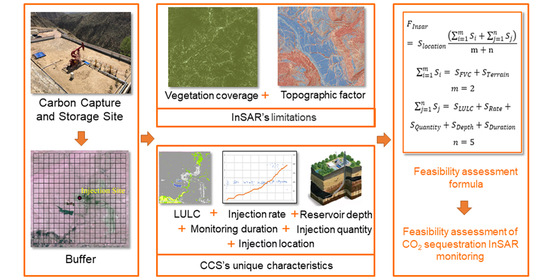Analysis of Available Conditions for InSAR Surface Deformation Monitoring in CCS Projects
Abstract
:1. Introduction
2. Feasibility of Monitoring CCS Using the InSAR Technique
3. Influencing Factors of InSAR Monitoring in a CCS Project
3.1. Vegetation Coverage
3.2. Topographic Factor
3.3. Reservoir Location
3.4. Land Use/Land Cover
3.5. Injection Rate
3.6. Injection Quantity
3.7. Reservoir Depth
3.8. Monitoring Duration
4. InSAR Feasibility Assessment of a CCS Site
4.1. Evaluation Methods
4.2. Feasibility Assessment
5. Discussion
6. Conclusions
- (1)
- InSAR technology is a potential monitoring method for CCS sequestration leakage and migration, but it is still in its infancy. More than 130 CCS sequestration areas were utilized in this study, but less than 10 were monitored using the InSAR technique. In addition, the results were also uneven. The reasons are complex and varied, but they can be divided into the characteristic limitations of InSAR technology and the special requirements of CCS sequestration. Therefore, a parameter is required to assess whether InSAR monitoring is viable for a specific region.
- (2)
- InSAR technology still has technical limitations for monitoring surface deformation, especially in complex mountainous areas. Due to safety considerations, CCS storage areas are often built far away from cities, including mountains and deserts. These places are inevitably faced with layout, foreshortening, and other incoherence phenomena, resulting in the absence and inaccuracy of results. In this study, the fractional vegetation cover and R-index were selected to evaluate the influence of vegetation and topography on the results of InSAR, so as to evaluate the feasibility of InSAR.
- (3)
- The use of InSAR technology also has certain requirements for the injection mode and the injection area. According to limitations in the field design and the injection plan, the injection rate and injection amount of each storage area were different. However, a slow and small amount of injection had an extremely insignificant and irregular response on the surface deformation, and the regular deformation trend could not be identified. Hence, it could not be determined whether CO2 injection was the primary controlling factor of the surface deformation. Therefore, we evaluated the injection volume, injection depth, injection rate, land use/land cover, reservoir type, and monitoring duration. Given the fixed evaluation criteria, we concluded that a large amount and stable injection were suitable for deformation monitoring, so as to realize the feasibility evaluation of InSAR technology in CO2 sequestration areas.
- (4)
- To comprehensively evaluate the feasibility of InSAR monitoring in CO2 sequestration areas, an evaluation model of the InSAR feasibility was established according to the characteristics of InSAR and the CCS sequestration areas. For a typical injection area or under injection areas, suggestions were made on whether InSAR can be used for monitoring. In addition, the cases of successful application and failure to detect deformation were verified. The cases of successful monitoring and the cases wherein deformation was not accurately detected were both used to validate the evaluation parameters. The results demonstrated that most of the sequestration areas were suitable for the InSAR technique, and the feasibility was consistent with the collected data.
Author Contributions
Funding
Acknowledgments
Conflicts of Interest
References
- Friedlingstein, P.; O’Sullivan, M.; Jones, M.W.; Andrew, R.M.; Hauck, J.; Olsen, A.; Peters, G.P.; Peters, W.; Pongratz, J.; Sitch, S.; et al. Global Carbon Budget 2020. Earth Syst. Sci. Data 2020, 12, 3269–3340. [Google Scholar] [CrossRef]
- Tapia, J.F.D.; Lee, J.Y.; Ooi, R.E.H.; Foo, D.C.Y.; Tan, R.R. A review of optimization and decision-making models for the planning of CO2 capture, utilization and storage (CCUS) systems. Sustain. Prod. Consum. 2018, 13, 1–15. [Google Scholar] [CrossRef]
- Zendehboudi, S.; Khan, A.; Carlisle, S.; Leonenko, Y. Ex situ dissolution of CO2: A new engineering methodology based on mass-transfer perspective for enhancement of CO2 sequestration. Energy Fuels 2011, 25, 3323–3333. [Google Scholar] [CrossRef]
- Du, J.; Brissenden, S.J.; Mcglllivray, P.; Bourne, S.J.; Hofstra, P.; Davis, E.J.; Roadarmel, W.M.; Wolhart, S.L.; Wright, C.A. Mapping fluid flow in a reservoir using tiltmeter-based surface-deformation measurements. In Proceedings of the SPE Annual Technical Conference and Exhibition, Dallas, TX, USA, 9 October 2005; pp. 25–32. [Google Scholar] [CrossRef]
- IEAGHG. Monitoring and Modelling of CO2 Storage: The Potential for Improving the Cost-Benefit Ratio of Reducing Risk; IEAGHG Technical Report 2020–01; IEAGHG: Cheltenham, UK, February 2020. [Google Scholar]
- Zhang, T.; Zhang, W.; Yang, R.; Liu, Y.; Jafari, M. CO2 capture and storage monitoring based on remote sensing techniques: A review. J. Clean. Prod. 2021, 281, 124409. [Google Scholar] [CrossRef]
- Raziperchikolaee, S.; Cotter, Z.; Gupta, N. Assessing mechanical response of CO2 storage into a depleted carbonate reef using a site-scale geomechanical model calibrated with field tests and InSAR monitoring data. J. Nat. Gas Sci. Eng. 2021, 86, 103744. [Google Scholar] [CrossRef]
- Loschetter, A.; Rohmer, J.; Raucoules, D.; De Michele, M. Sizing a geodetic network for risk-oriented monitoring of surface deformations induced by CO2 injection: Experience feedback with InSAR data collected at In-Salah, Algeria. Int. J. Greenh. Gas Control 2015, 42, 571–582. [Google Scholar] [CrossRef]
- Peltier, A.; Froger, J.L.; Villeneuve, N.; Catry, T. Assessing the reliability and consistency of InSAR and GNSS data for retrieving 3D-displacement rapid changes, the example of the 2015 Piton de la Fournaise eruptions. J. Volcanol. Geotherm. Res. 2017, 344, 106–120. [Google Scholar] [CrossRef]
- Radutu, A.; Nedelcu, I.; Gogu, C.R. An overview of ground surface displacements generated by groundwater dynamics, revealed by InSAR techniques. Procedia Eng. 2017, 209, 119–126. [Google Scholar] [CrossRef]
- Bohloli, B.; Bjørnarå, T.I.; Park, J.; Rucci, A. Can we use surface uplift data for reservoir performance monitoring? A case study from In Salah, Algeria. Int. J. Greenh. Gas Control 2018, 76, 200–207. [Google Scholar] [CrossRef]
- Rutqvist, J.; Vasco, D.W.; Myer, L. Coupled reservoir-geomechanical analysis of CO2 injection and ground deformations at In Salah, Algeria. Int. J. Greenh. Gas Control 2010, 4, 225–230. [Google Scholar] [CrossRef] [Green Version]
- Mathieson, A.; Wright, I.; Roberts, D.; Ringrose, P. Satellite imaging to monitor CO2 movement at Krechba, Algeria. Energy Procedia 2009, 1, 2201–2209. [Google Scholar] [CrossRef] [Green Version]
- Vasco, D.W.; Rucci, A.; Ferretti, A.; Novali, F.; Bissell, R.C.; Ringrose, P.S.; Mathieson, A.S.; Wright, I.W. Satellite-based measurements of surface deformation reveal fluid flow associated with the geological storage of carbon dioxide. Geophys. Res. Lett. 2010, 37. [Google Scholar] [CrossRef] [Green Version]
- Yunjun, Z.; Fattahi, H.; Amelung, F. Small baseline InSAR time series analysis: Unwrapping error correction and noise reduction. Comput. Geosci. 2019, 133, 104331. [Google Scholar] [CrossRef] [Green Version]
- Onuma, T.; Ohkawa, S. Detection of surface deformation related with CO2 injection by DInSAR at In Salah, Algeria. Energy Procedia 2009, 1, 2177–2184. [Google Scholar] [CrossRef] [Green Version]
- Yang, Q.; Zhao, W.; Dixon, T.H.; Amelung, F.; Han, W.S.; Li, P. InSAR monitoring of ground deformation due to CO2 injection at an enhanced oil recovery site, West Texas. Int. J. Greenh. Gas Control 2015, 41, 20–28. [Google Scholar] [CrossRef] [Green Version]
- Guo, S.; Zheng, H.; Yang, Y.; Zhang, S.; Hou, H.; Zhu, Q.; Du, P. Spatial estimates of surface deformation and topsoil moisture in operating CO2-EOR project: Pilot environmental monitoring using SAR technique. J. Clean. Prod. 2019, 236, 117606. [Google Scholar] [CrossRef]
- Samsonov, S.; Czarnogorska, M.; White, D. Satellite interferometry for high-precision detection of ground deformation at a carbon dioxide storage site. Int. J. Greenh. Gas Control 2015, 42, 188–199. [Google Scholar] [CrossRef]
- Shi, J.; Yang, H.; Peng, J.; Wu, L.; Xu, B.; Liu, Y.; Zhao, B. InSAR Monitoring and Analysis of Ground Deformation Due to Fluid or Gas Injection in Fengcheng Oil Field, Xinjiang, China. J. Indian Soc. Remote Sens. 2019, 47, 455–466. [Google Scholar] [CrossRef]
- Li, Z.; Duan, M.; Cao, Y.; Mu, M.; He, X.; Wei, J. Mitigation of time-series InSAR turbulent atmospheric phase noise: A review. Geod. Geodyn. 2022, 1–11. [Google Scholar] [CrossRef]
- Gabriel, A.K.; Goldstein, R.M.; Zebker, H.A. Mapping small elevation changes over large areas: Differential radar interferometry. J. Geophys. Res. 1989, 94, 9183–9191. [Google Scholar] [CrossRef]
- Bai, Z.; Fang, S.; Gao, J.; Zhang, Y.; Jin, G.; Wang, S.; Zhu, Y.; Xu, J. Could Vegetation Index be Derive from Synthetic Aperture Radar?—The Linear Relationship between Interferometric Coherence and NDVI. Sci. Rep. 2020, 10, 6749. [Google Scholar] [CrossRef] [Green Version]
- Gao, L.; Wang, X.; Johnson, B.A.; Tian, Q.; Wang, Y.; Verrelst, J.; Mu, X.; Gu, X. Remote sensing algorithms for estimation of fractional vegetation cover using pure vegetation index values: A review. ISPRS J. Photogramm. Remote Sens. 2020, 159, 364–377. [Google Scholar] [CrossRef]
- Jia, K.; Liang, S.; Liu, S.; Li, Y.; Xiao, Z.; Yao, Y. Global Land Surface Fractional Vegetation Cover Estimation Using General Regression Neural Networks From MODIS Surface Reflectance. IEEE Trans. Geosci. Remote Sens. 2015, 53, 4787–4796. [Google Scholar] [CrossRef]
- Colesanti, C.; Wasowski, J. Investigating landslides with space-borne Synthetic Aperture Radar (SAR) interferometry. Eng. Geol. 2006, 88, 173–199. [Google Scholar] [CrossRef]
- Cigna, F.; Bateson, L.B.; Jordan, C.J.; Dashwood, C. Simulating SAR geometric distortions and predicting Persistent Scatterer densities for ERS-1/2 and ENVISAT C-band SAR and InSAR applications: Nationwide feasibility assessment to monitor the landmass of Great Britain with SAR imagery. Remote Sens. Environ. 2014, 152, 441–466. [Google Scholar] [CrossRef] [Green Version]
- Notti, D.; Davalillo, J.C.; Herrera, G.; Mora, O. Assessment of the performance of X-band satellite radar data for landslide mapping and monitoring: Upper Tena Valley case study. Nat. Hazards Earth Syst. Sci. 2010, 10, 1865–1875. [Google Scholar] [CrossRef]
- Dai, Z.; Viswanathan, H.; Xiao, T.; Middleton, R.; Pan, F.; Ampomah, W.; Yang, C.; Zhou, Y.; Jia, W.; Lee, S.Y.; et al. CO2 Sequestration and Enhanced Oil Recovery at Depleted Oil/Gas Reservoirs. Energy Procedia 2017, 114, 6957–6967. [Google Scholar] [CrossRef]
- Mukherjee, M.; Misra, S. A review of experimental research on Enhanced Coal Bed Methane (ECBM) recovery via CO2 sequestration. Earth-Sci. Rev. 2018, 179, 392–410. [Google Scholar] [CrossRef]
- Jayasekara, D.W.; Ranjith, P.G.; Wanniarachchi, W.A.M.; Rathnaweera, T.D. Understanding the chemico-mineralogical changes of caprock sealing in deep saline CO2 sequestration environments: A review study. J. Supercrit. Fluids 2020, 161, 104819. [Google Scholar] [CrossRef]
- Li, Q.; Wu, Z.; Li, X. Prediction of CO2 leakage during sequestration into marine sedimentary strata. Energy Convers. Manag. 2009, 50, 503–509. [Google Scholar] [CrossRef]
- Xiong, Z.; Li, T.; Crosta, X.; Algeo, T.; Chang, F.; Zhai, B. Potential role of giant marine diatoms in sequestration of atmospheric CO2 during the Last Glacial Maximum: δ13C evidence from laminated Ethmodiscus rex mats in tropical West Pacific. Glob. Planet. Change 2013, 108, 1–14. [Google Scholar] [CrossRef]
- Ren, Y.; Lü, Y.; Comber, A.; Fu, B.; Harris, P.; Wu, L. Spatially explicit simulation of land use/land cover changes: Current coverage and future prospects. Earth-Sci. Rev. 2019, 190, 398–415. [Google Scholar] [CrossRef]
- NRSCC. Global Ecosystems and Environment Observation Analysis Report Cooperation (GEOARC) 2017; NRSCC: Beijing, China, 2017. [Google Scholar]
- Cao, D.; Zhang, J.; Xun, L.; Yang, S.; Wang, J.; Yao, F. Spatiotemporal variations of global terrestrial vegetation climate potential productivity under climate change. Sci. Total Environ. 2021, 770, 145320. [Google Scholar] [CrossRef]
- Sreejith, K.M.; Agrawal, R.; Agram, P.; Rajawat, A.S. Surface deformation of the Barren Island volcano, Andaman Sea (2007–2017) constrained by InSAR measurements: Evidence for shallow magma reservoir and lava field subsidence. J. Volcanol. Geotherm. Res. 2020, 407, 107107. [Google Scholar] [CrossRef]
- Abdel-Hamid, A.; Dubovyk, O.; Greve, K. The potential of sentinel-1 InSAR coherence for grasslands monitoring in Eastern Cape, South Africa. Int. J. Appl. Earth Obs. Geoinf. 2021, 98, 102306. [Google Scholar] [CrossRef]
- Teng, Y.; Liu, Y.; Lu, G.; Jiang, L.; Wang, D.; Song, Y. Experimental Evaluation of Injection Pressure and Flow Rate Effects on Geological CO2 Sequestration Using MRI. Energy Procedia 2017, 114, 4986–4993. [Google Scholar] [CrossRef]
- Zheng, Y.; Liu, J.; Zhang, B. The Influence of Geological Storage of Carbon Dioxide on Deformation of Ground Surface in Depleted Reservoirs. J. Hebei Geo Univ. 2019, 2, 1–6. [Google Scholar] [CrossRef]
- Schaef, H.T.; McGrail, B.P.; Owen, A.T. Basalt reactivity variability with reservoir depth in supercritical CO2 and aqueous phases. Energy Procedia 2011, 4, 4977–4984. [Google Scholar] [CrossRef] [Green Version]
- Murdoch, L.C.; Germanovich, L.N.; DeWolf, S.J.; Moysey, S.M.J.; Hanna, A.C.; Kim, S.; Duncan, R.G. Feasibility of using in situ deformation to monitor CO2 storage. Int. J. Greenh. Gas Control 2020, 93, 102853. [Google Scholar] [CrossRef]
- Hannis, S.; Lu, J.; Chadwick, A.; Hovorka, S.; Kirk, K.; Romanak, K.; Pearce, J. CO2 Storage in Depleted or Depleting Oil and Gas Fields: What can We Learn from Existing Projects? Energy Procedia 2017, 114, 5680–5690. [Google Scholar] [CrossRef]
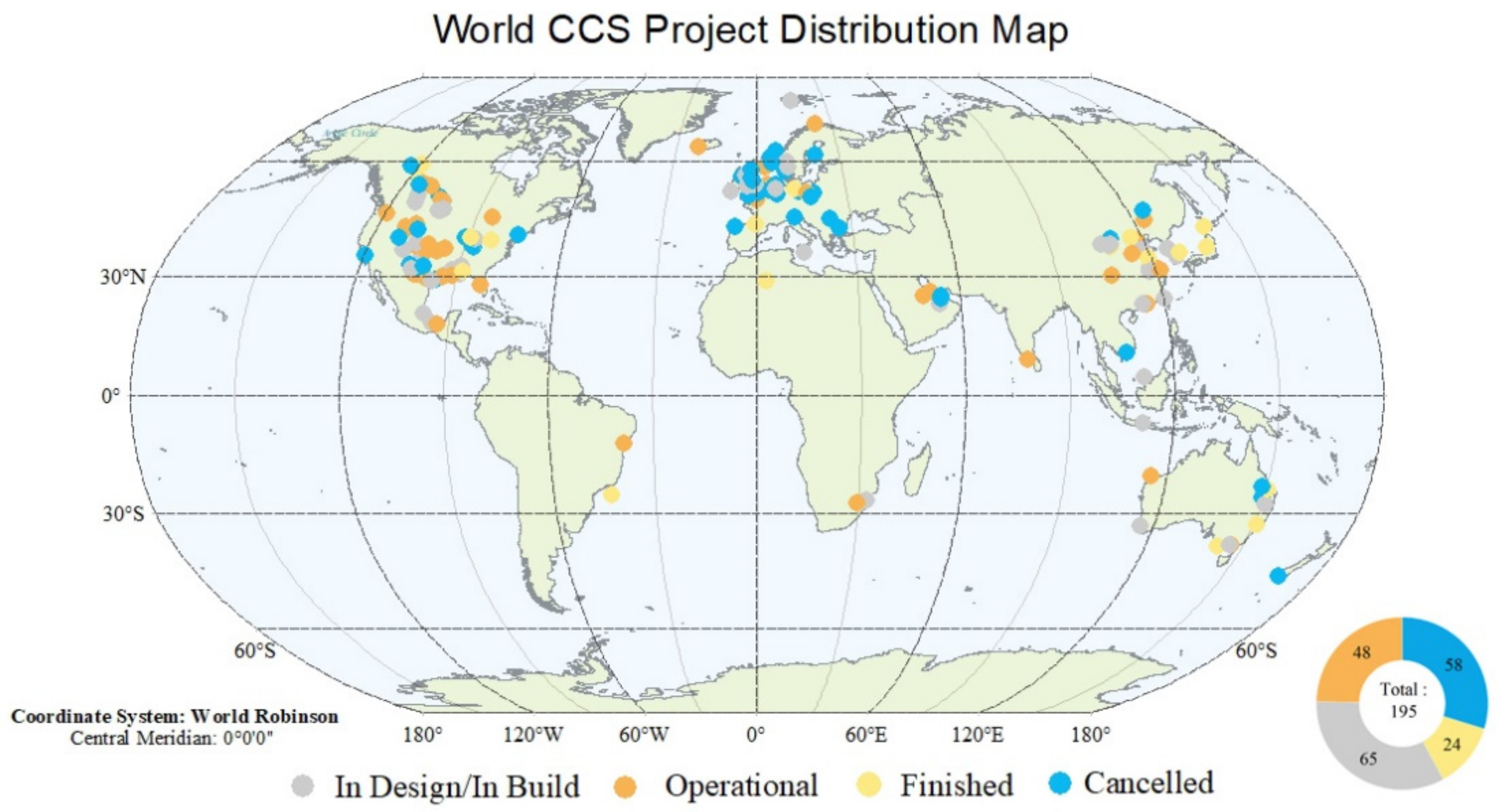
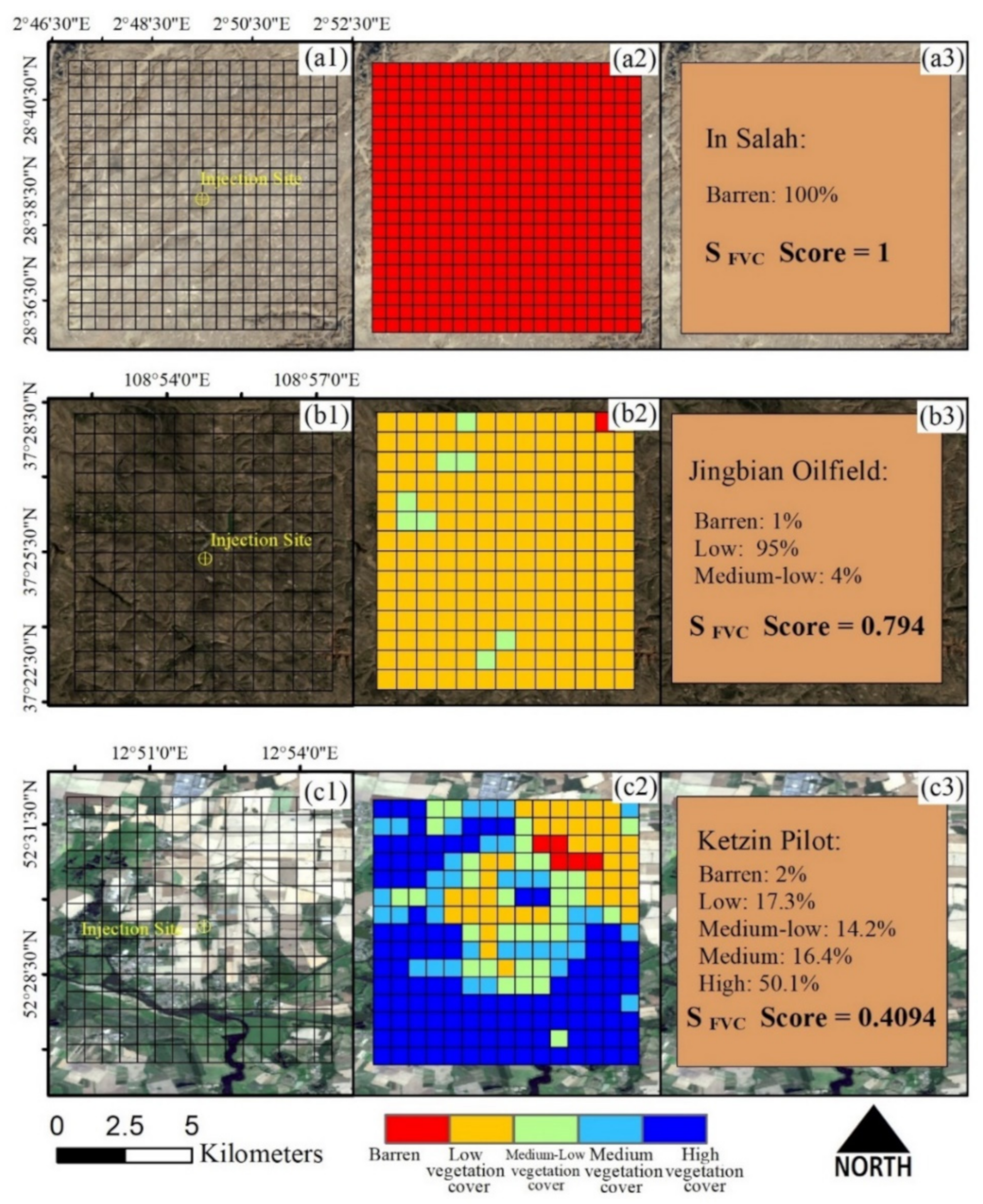
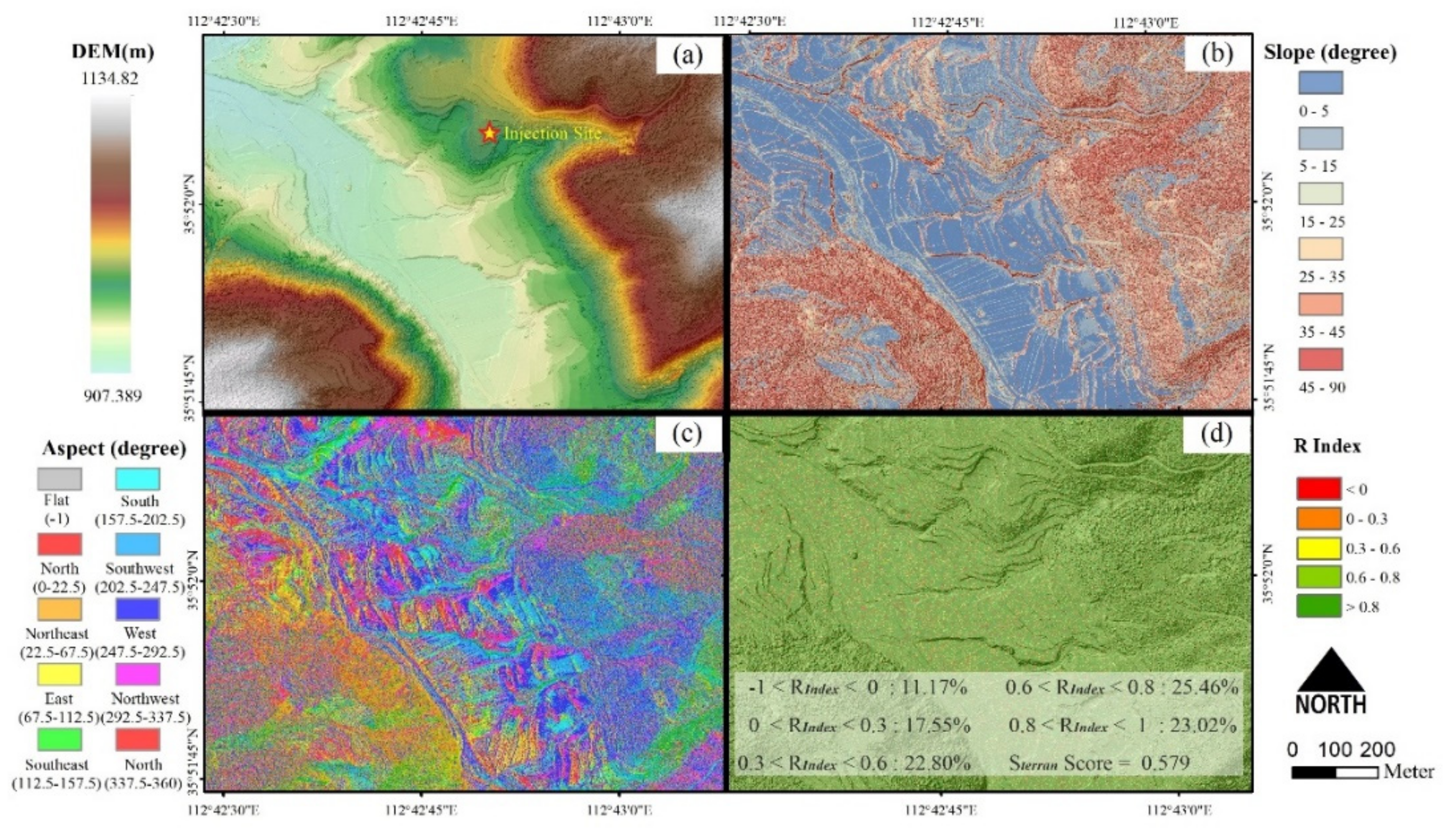
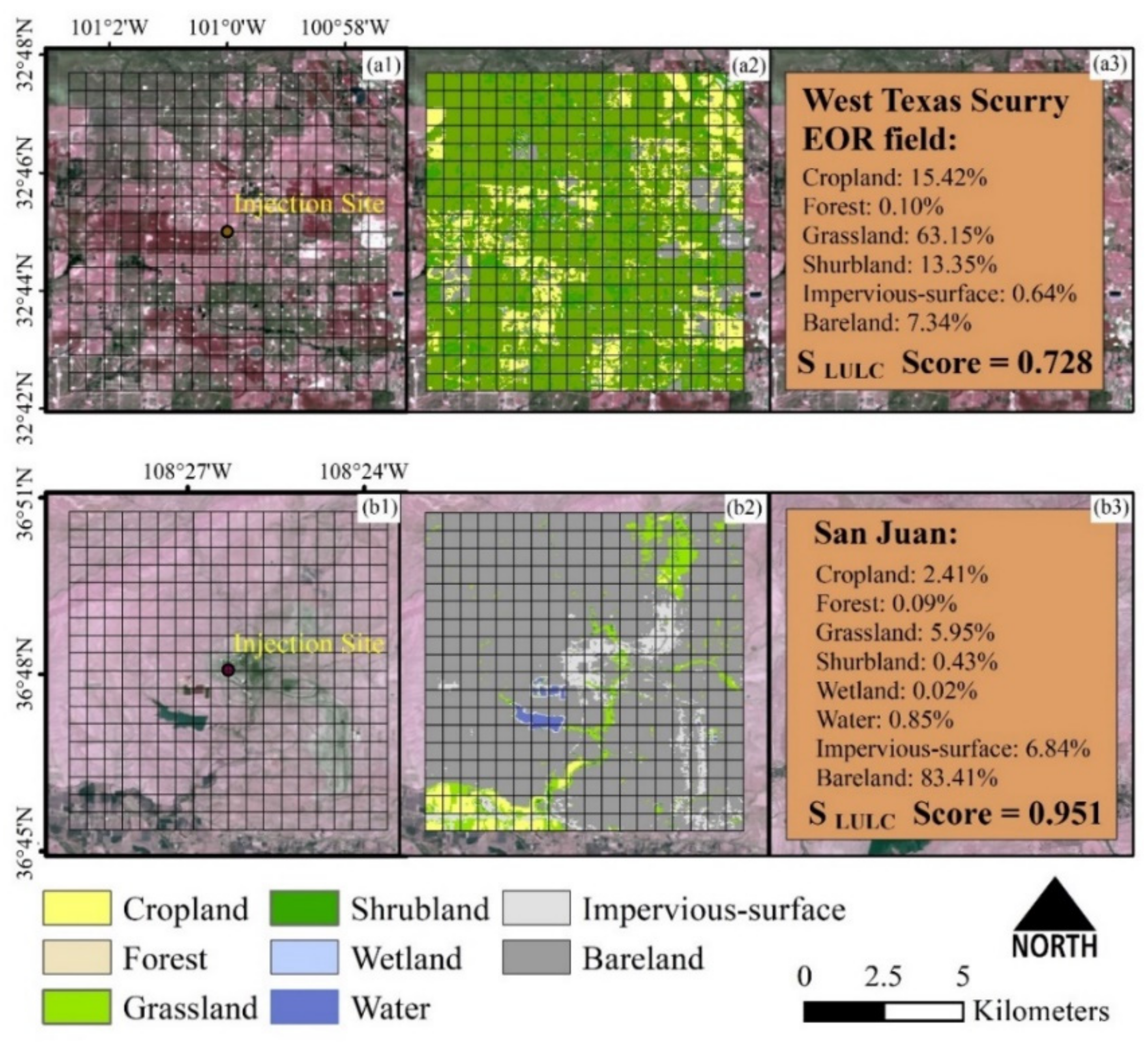
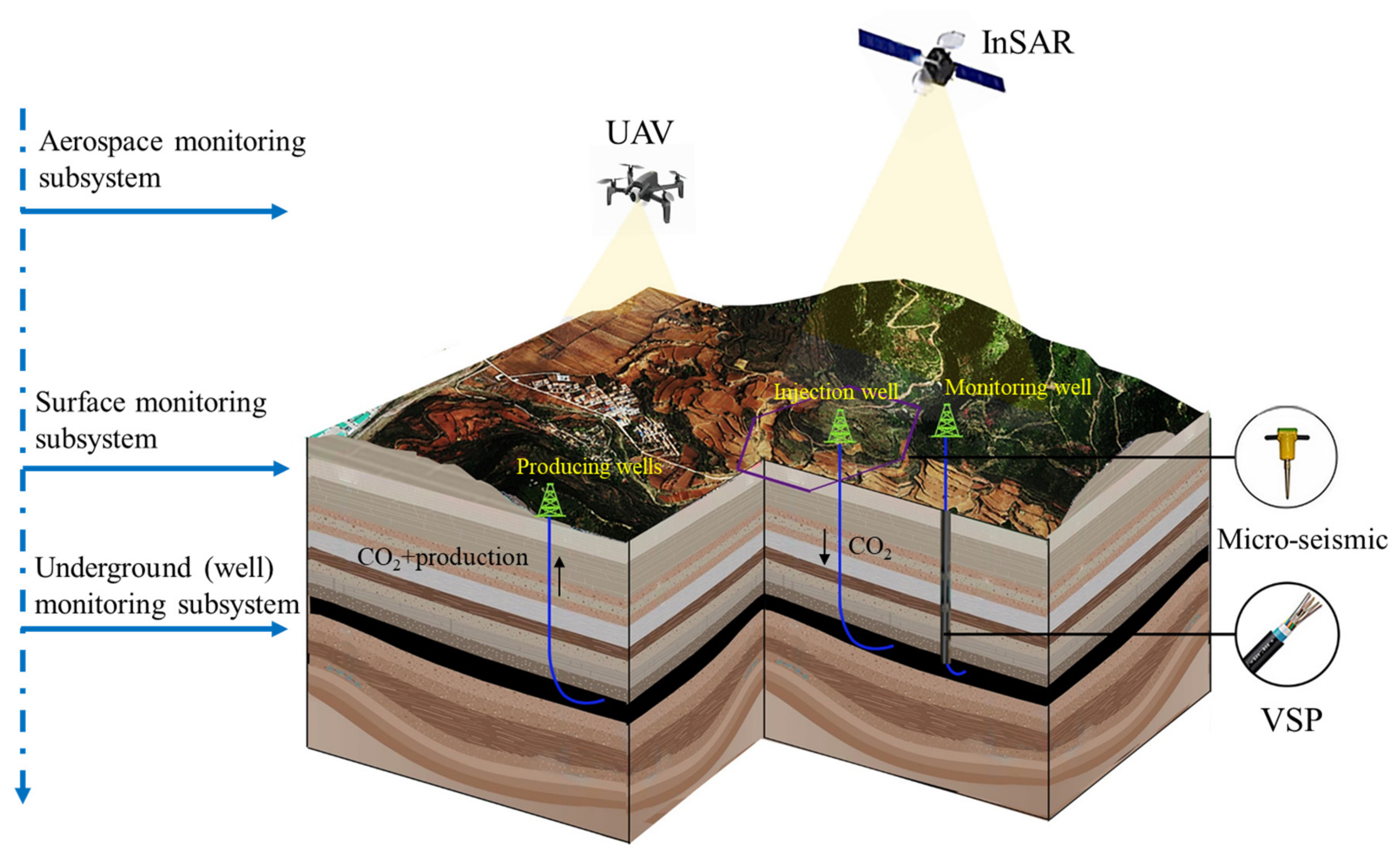
| FVC | Surface Type | Score |
|---|---|---|
| 0–0.1 | Barren | 1.0 |
| 0.1–0.3 | Low coverage | 0.8 |
| 0.3–0.45 | Medium-low coverage | 0.6 |
| 0.45–0.6 | Medium coverage | 0.4 |
| 0.6–1 | High coverage | 0.2 |
| Classes | Pixel Compression | Score |
|---|---|---|
| ≤0 | Layout/foreshortening | 0 |
| 0–0.3 | High–bad slope | 0.25 |
| 0.3–0.6 | Medium slope | 0.5 |
| 0.6–0.8 | Low good slope | 0.75 |
| >0.8 | Very low good slope | 1 |
| Reservoir Location | Score |
|---|---|
| Onshore | 1 |
| Offshore | 0 |
| Applicability of InSAR Technique | NRSCC Classification | Score |
|---|---|---|
| Very suitable | Bare land | 1.0 |
| Suitable | Grassland | 0.8 |
| Impervious surface | ||
| Suspectable/As appropriate | Forest | 0.5 |
| Tundra | ||
| Cropland | ||
| Shrubland | ||
| Not suitable | Water | 0 |
| Wetland | ||
| Snow and Ice |
| Injection Rate (m3/Day) | Score |
|---|---|
| <30 | 0.2 |
| 30–150 | 0.4 |
| 150–2000 | 0.6 |
| 2000–8000 | 0.8 |
| >8000 | 1 |
| Total Injection Quantity (Mt) | Score |
|---|---|
| <0.01 | 0.2 |
| 0.01–0.1 | 0.4 |
| 0.01–0.05 | 0.6 |
| 0.05–1.0 | 0.8 |
| >1.0 | 1 |
| Reservoir Depth (km) | Score |
|---|---|
| 0.5–1.5 | 1 |
| 1.5–2.5 | 0.8 |
| 2.5–4 | 0.6 |
| >4 | 0.4 |
| Duration (Year) | Score |
|---|---|
| <1 | 0.5 |
| 1–3 | 0.8 |
| 3–5 | 1.0 |
| >5 | 0.8 |
| Score | Feasibility |
|---|---|
| 0 | Not applicable |
| 0.1–0.3 | May be applicable |
| 0.3–0.6 | Applicable |
| 0.6–0.9 | Strongly applicable |
| 0.9–1.0 | Highly recommended |
| Project Name | Reservoir Location | Vegetation Coverage | Topographic Factor | LULC | Injection Rate (m3/Day) | Total Injection (Mt) | Reservoir Depth (km) | Duration (Year) | Country | Scale | Status | |
|---|---|---|---|---|---|---|---|---|---|---|---|---|
| Al Reyadah | Onshore (54.47, 24.32) | Medium-low coverage | Very low good slope | Bare land | 1,170,000 | 1.6 | 2.5 | 2 | United Arab Emirates | Commercial | Operational | 0.912 |
| Frio | Onshore (−94.80, 30.00) | Medium-low coverage | Very low good slope | Forest | 87,200 | 1.4 | 1.5 | 4 | USA | Commercial | Finished | 0.881 |
| Shizhuang ECBM Pilot | Onshore (112.71, 35.87) | Low coverage | Medium slope | Cropland | 5450 | 0.025 | 0.7 | 2 | China | Pilot | Operational | 0.718 |
| In Salah | Onshore (2.82, 28.64) | Barren | Very low good slope | Bare land | 1,792,000 | 14.0 | 1.8 | 7 | Algeria | Commercial | Finished | 0.993 |
| Ketzin | Onshore (12.87, 52.49) | High coverage | Low good slope | Cropland | 54,500 | 0.06 | 0.7 | 3 | Germany | Pilot | Finished | 0.756 |
| Lanxes Newcastle | Onshore (29.97, −27.78) | Barren | Very low good slope | Bare land | 92,650 | 0.12 | 1.0 | 2 | South Africa | Pilot | Operational | 0.930 |
| Lotte CCUS Project | Offshore (−1.11, 54.58) | / | / | / | / | / | / | / | UK | Pilot | In Design | 0 |
| Otway Basin | Onshore (150.63, −24.33) | Low coverage | Low good slope | Impervious surface | 81,750 | 0.075 | 2.0 | 10 | Australia | Pilot | Finished | 0.842 |
| PEMEX EOR Pilot | Onshore (−94.56, 18.00) | Medium coverage | Medium slope | Impervious surface | 50,000 | 0.5 | 1.8 | 1 | Mexico | Commercial | In Design | 0.522 |
| Ras Laffan | Onshore (51.54, 25.91) | Barren | Low good slope | Bare land | 300,000 | 2.1 | 1.0 | 1 | Qatar | Commercial | Operational | 0.656 |
| RECOPOL | Onshore (16.84, 51.47) | Medium-low | Medium slope | Cropland | 510 | 0.0001 | 1.1 | 1 | Poland | Pilot | Operational | 0.699 |
| ROAD | Offshore (4.02, 51.96) | / | / | / | / | / | / | / | Netherlands | Pilot | Finished | 0 |
| San Juan | Onshore (−108.44, 36.80) | Barren | Very low good slope | Bare land | 2100 | 0.104 | 0.8 | 5 | USA | Commercial | Finished | 0.815 |
| Shenhua Ordos Pilot | Onshore (110.15, 39.33) | Low coverage | Low good slope | Impervious surface | 60,000 | 0.3 | 2.7 | 3 | China | Pilot | Finished | 0.632 |
| Sleipner | Offshore (3.00, 58.41) | / | / | / | / | / | / | / | Norway | Commercial | Finished | 0 |
| Tomakomai CCS Project | Offshore (141.65, 42.63) | / | / | / | / | / | / | / | Japan | Commercial | Finished | 0 |
| Lacq | Onshore (−0.67, 43.44) | Low coverage | Very low good slope | Grassland | 109,000 | 0.012 | 4.5 | 2 | France | Commercial | Operational | 0.843 |
| Uthmaniyah EOR Project | Onshore (49.36, 24.80) | Barren | Very low good slope | Bare land | 1,274,000 | 4.0 | 3.6 | 5 | Saudi Arabia | Pilot | Operational | 0.883 |
| West Texas Scurry field | Onshore (−101.09, 32.07) | Low coverage | Low good slope | Grassland | 90,000 | 55.0 | 2.0 | 35 | USA | Commercial | Finished | 0.712 |
| Weyburn CO2 Project | Onshore (−103.68, 49.51) | Barren | Low good slope | Grassland | 7,085,000 | 25.0 | 1.5 | 15 | Canada | Commercial | Operational | 0.832 |
| Yangchang Jingbian | Onshore (108.91, 37.42) | Low coverage | Medium slope | Grassland | 7000 | 0.005 | 3.0 | 5 | China | Pilot | Finished | 0.694 |
| Youngil Bay | Offshore (129.46, 36.06) | / | / | / | / | / | / | / | South Korea | Pilot | Finished | 0 |
Publisher’s Note: MDPI stays neutral with regard to jurisdictional claims in published maps and institutional affiliations. |
© 2022 by the authors. Licensee MDPI, Basel, Switzerland. This article is an open access article distributed under the terms and conditions of the Creative Commons Attribution (CC BY) license (https://creativecommons.org/licenses/by/4.0/).
Share and Cite
Zhang, T.; Zhang, W.; Yang, R.; Gao, H.; Cao, D. Analysis of Available Conditions for InSAR Surface Deformation Monitoring in CCS Projects. Energies 2022, 15, 672. https://doi.org/10.3390/en15020672
Zhang T, Zhang W, Yang R, Gao H, Cao D. Analysis of Available Conditions for InSAR Surface Deformation Monitoring in CCS Projects. Energies. 2022; 15(2):672. https://doi.org/10.3390/en15020672
Chicago/Turabian StyleZhang, Tian, Wanchang Zhang, Ruizhao Yang, Huiran Gao, and Dan Cao. 2022. "Analysis of Available Conditions for InSAR Surface Deformation Monitoring in CCS Projects" Energies 15, no. 2: 672. https://doi.org/10.3390/en15020672
APA StyleZhang, T., Zhang, W., Yang, R., Gao, H., & Cao, D. (2022). Analysis of Available Conditions for InSAR Surface Deformation Monitoring in CCS Projects. Energies, 15(2), 672. https://doi.org/10.3390/en15020672





